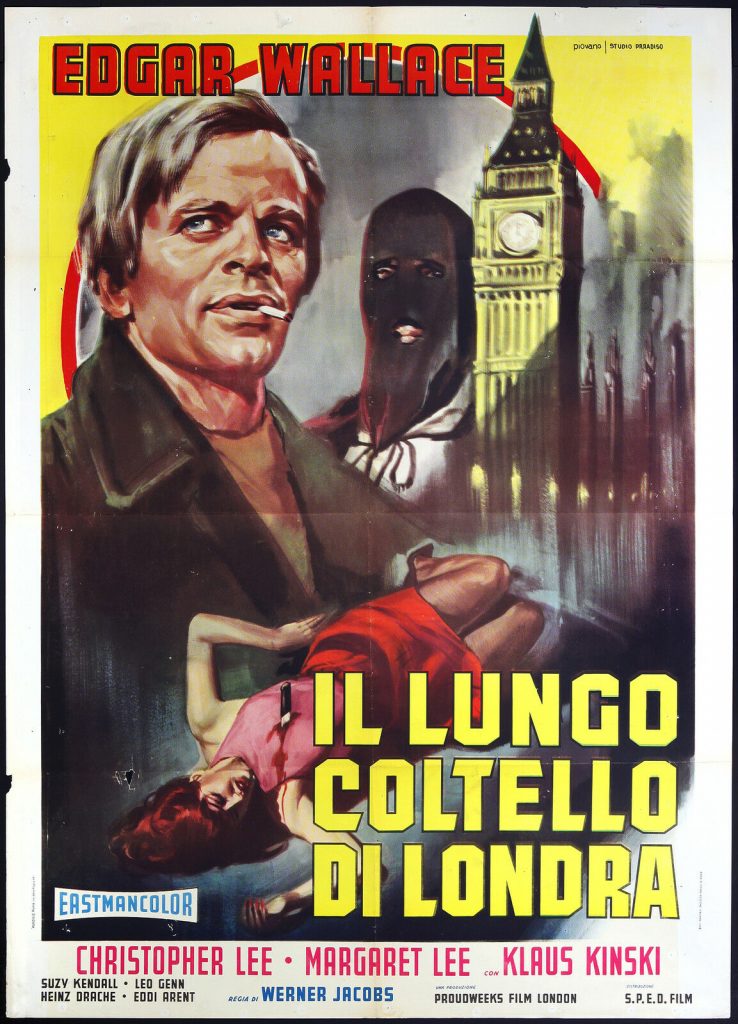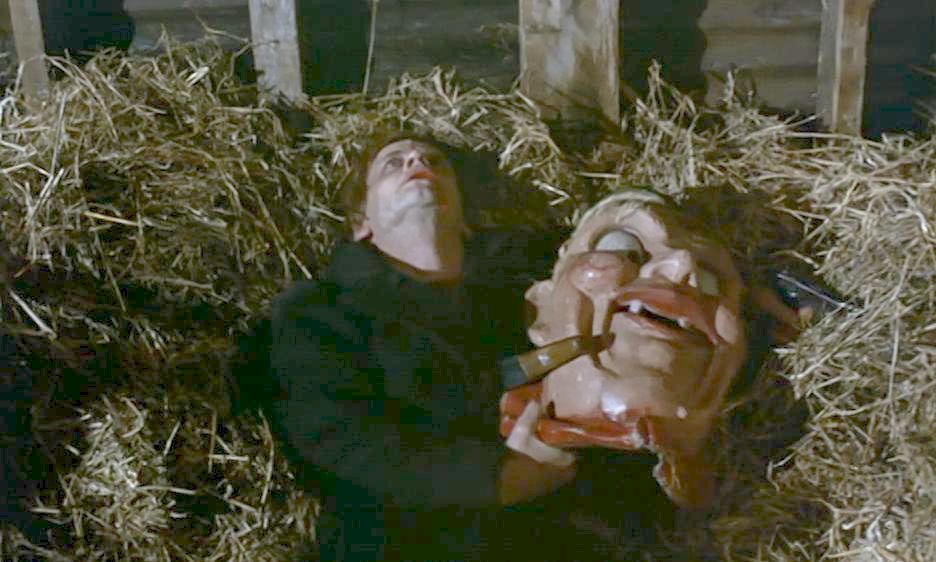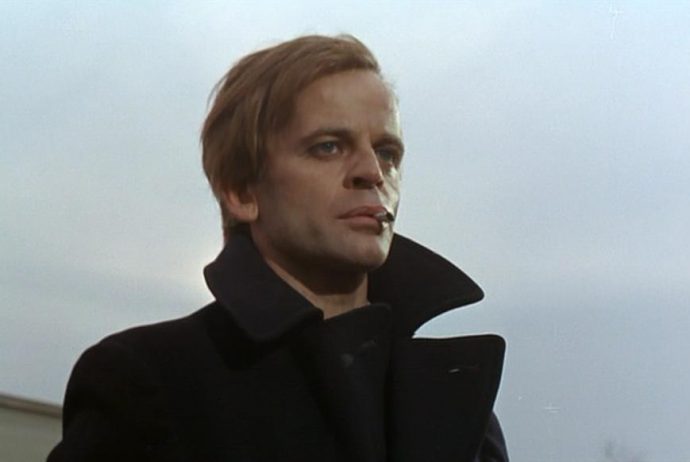Dir: John Moxey
Star: Leo Genn, Christopher Lee, Anthony Newlands, Klaus Kinski
a.k.a. Circus of Fear
Regardless of what the IMDb says, I’d say that Circus was less the “also known as” than Psycho. The former was the original title for this British production. The rather more lurid name was applied for its American release, which also slashed close to half an hour from the running time. I’ve no idea what this did to the coherence of what is a pretty busy plot, but it can’t have been good. There is even a third alternative version: when released in Germany, this color production was shown in black-and-white. This was done in order to make it more consistent with the local Edgar Wallace productions, which were not yet being made in colour.
For, despite its thoroughly British setting, and largely British cast, this is a krimi, apparently based on Wallace’s novel, The Three Just Men (though some sources cite other books). It was co-produced by Constantin Film, who were also responsible, with local studio Rialto, for most of the German adaptations of Wallace’s work. Several of these were supposedly set in Britain, e.g. The Dead Eyes of London, though stock footage typically played an important role in establishing the locale for these. No such subterfuge was used here, with the movie shot at Bray Studios, the home of Hammer Films, and on location around the South of England. Billy Smart’s Circus, a British icon of the time, provided the circus setting, as it also did for other sixties productions, including Circus of Horrors and Berserk.
However, to improve the cross-over appeal, several English-speaking stars of the German franchise were sent over to the UK to take part. Not only Klaus is present, but also Eddi Arent, another veteran of many of the Rialto krimis, making a relatively rare (especially compared to Kinski’s globe-trotting career) excursion into another country’s film industry. He plays the circus accountant, Eddie, who wants to become a performer in the ring. Heinz Drache also appears, as circus ring-master Carl. But it’s a while before anything tent-related shows up. Initially, this is a heist film, with an armored car being held up and robbed of its cash contents on Tower Bridge, the perpetrators getting away down the Thames, by boat. Kinski plays Manfred Hart, the smuggler charged with getting the loot out of the country.

However, there’s a wrinkle, in that a member of the gang, Mason (played by Victor Maddern, a face familiar from many Brit-flicks of the time) shoots one of the van’s guards, who subsequently dies. Mason is sent off to deliver the loot to a location near Windsor, but ends up with a knife thrown into his back. Some of the stolen and now vanished money starts turning up in local businesses, drawing the attention of Scotland Yard’s Inspector Elliott (Genn), who is under increasing pressure from his boss to find the culprits and recover the cash. His attention is drawn to Barberini’s Circus, wintering nearby. But when he starts to investigate it and its owner (Newlands), this opens an entirely new and even more murderous can of criminal worms. Not helping the overall sense of menace is Hart’s presence, as he also seeks to find the cash-filled suitcase.
For the circus itself has no shortage of odd characters, probably headlined by Gregor the lion-tamer (Lee), who wears a mask to conceal a badly-scarred face. There’s also a hyper-jealous knife thrower, his wandering fiancee (Margaret Lee), Gregor’s niece (Suzy Kendall), the ring-master and Eddie the accountant mentioned above, plus a midget (Skip Martin) with a fondness for lurking in the shadows and blackmail. By the time all is said and done, there will be multiple further dead bodies, and the original heist will be all but forgotten by Inspector Elliott. The finale, in which he gathers the performers together in the ring, is instead all about revealing the circus shenanigans. The question of the mysterious “Mister Big” behind the robbery, whose anonymity is specifically mentioned early on, is never answered.
Despite the (quite glorious) Italian poster above, and also gracing the film’s opening shot, Kinski is very much a supporting character, working again for producer Harry Alan Towers, who wrote the screenplay here under the pseudonym of Peter Welbeck. Like the midget, Hart spends most of his time lurking in the shadows, in his case watching to see if he can figure out the loot’s location before Elliott does. There’s only one scene at the circus where he has much to say for himself, an oddity where he pops in to ask for a job, presumably in an effort to go undercover. He’s rather less than forthcoming with the requested personal information, shall we say:
Carl: What’s your name?
Hart: That’s my business.
Carl: I see. Have you ever worked in the circus before?
Hart: Maybe.

Unsurprisingly, he’s not employed, and thereafter, Hart is back to lurking on the outside. He meets an undignified fate, also at the business end of a throwing knife. Though as shown above, Hart does get to clutch a gigantic carnival-esque head as he goes down to the straw in the barn of his demise. There is, however, enough other stuff going on here, that the viewer may hardly even notice – perhaps after a brief pause, to cross Hart off the list of possible killers. The film does a fairly good job of keeping the multiple different threads moving, and I’ll confess that I didn’t guess the identity of the killer until it was revealed. However, I will say that the usual guideline of it being the least likely person, might get you pointed in the right direction.
It does feel a bit of a waste to have an icon like Lee spend 90% of the film hidden behind a ski-mask, even if there’s no concealing his sonorous tones, or his imposing figure. But this is an ensemble piece, with Lee taking a back-seat to Genn, who delivers a nicely likeable turn. I was especially amused with the way Elliott deftly handles his irascible boss, and was also struck by the footage of London and Docklands, pre-gentrification, which really adds to the period air. All told, I felt this was very much the equal of any of the German Wallace adaptations, and didn’t even mind the relatively early exit of Kinski too much.
